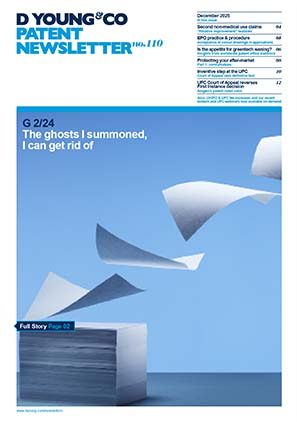Patenting industrial AI in Europe
While AI assistants, LLMs (large language models) and generative AI are beginning to dramatically change our work and home lives, AI is also expected to play an increasingly important role in industry. Whether helping to more accurately diagnose factory faults based on equipment drawings and maintenance records or providing locally-run AI agents able to help human technicians more quickly find relevant information in a given manufacturing environment, industrial AI has the potential to make industrial processes more productive, efficient and robust.
AI patents at the European Patent Office (EPO)
As with all new technology, creating new and useful industrial AI technology requires significant investment. Obtaining patent protection can be one way of helping secure a return on this investment.
Technical effect
At the EPO, AI models are classed as computer-implemented inventions (CIIs). A technical effect must therefore be demonstrated in order for a patent application directed to a new industrial AI model to be found allowable. This is because only claimed features exhibiting a technical effect may contribute to an inventive step at the EPO.
There are two key ways in which CIIs such as a new AI model may demonstrate a technical effect at the EPO: technical application or specific technical implementation. Technical application relates to the purpose of the AI and whether or not this is technical. Specific technical implementation relates to whether the AI is particularly adapted to take into account the internal functioning of the computer system which implements it.
The purpose of an industrial AI is often to solve problems directly related to a physical industrial process such as fault finding, equipment monitoring or process control. There will likely be strong arguments that such problems are inherently technical in nature and that an AI addressing such problems is thus directed to a technical application.
In addition, there may well be problems associated with the technical implementation of AI models in an industrial environment which are solved with a new AI. Such problems could include, for example, requirements for low power consumption, low latency and/or an ability to operate in unreliable communication conditions (as often found in large covered warehouses and factory buildings). There will again likely be strong arguments that AI solutions with new features which address such implementation problems exhibit a technical effect.
New industrial AI solutions may thus exhibit a technical effect through technical application, specific technical implementation or both. As long this is apparent from the teachings of the patent application, there is a good chance of such an industrial AI being found to have a suitable technical effect at the EPO.
Training data
If a new industrial AI relies on a new machine learning model, it is also critical to include in the patent application at least one full example of how the machine learning model might be implemented in order to meet the EPO’s sufficiency requirements. In particular, it is important to give an example of the model type and any specific architecture used and an indication of the training data which could be used to train the model. Not including this information can lead to sufficiency objections being raised by the EPO. These are often extremely difficult to overcome and can be fatal for a European patent application.
The extent of the training data that needs to be included typically varies on a case-by-case basis and your European patent attorney can advise accordingly. However, in general, while it may not always be practical to provide hundreds of pages of real training data as part of a patent application, enough information should be provided to enable a person skilled in the art (for example, an AI software engineer) to understand the nature of the training data, how much of it is needed and how it should be used to carry out the training.
Conclusion
The use of new AI technology is one way in which industry is looking to address the challenges of satisfying the ever-increasing demands for the products of industry (whether these be electric cars, air conditioners or microchips) in an increasingly complex and uncertain world. Patent protection can be a powerful way to help secure a return on the significant levels of investment required in creating such AI technology. At the EPO, new industrial AI technology may well be patentable as long as a technical effect can be demonstrated and sufficient information on any training data is provided.
For more information or specific advice on any of the issues raised in this article, please feel free to contact the author or your usual D Young & Co representative.

